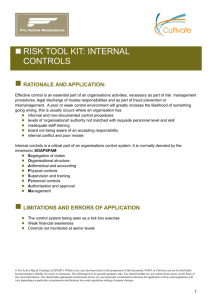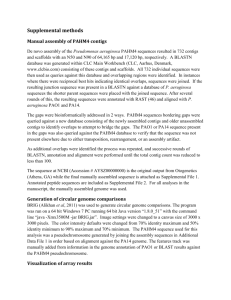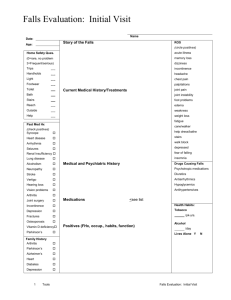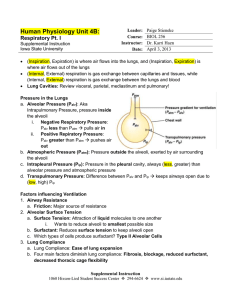A phenological examination of terrestrial invertebrate abundance, H. J. Andrews Experimental Forest, OR
advertisement
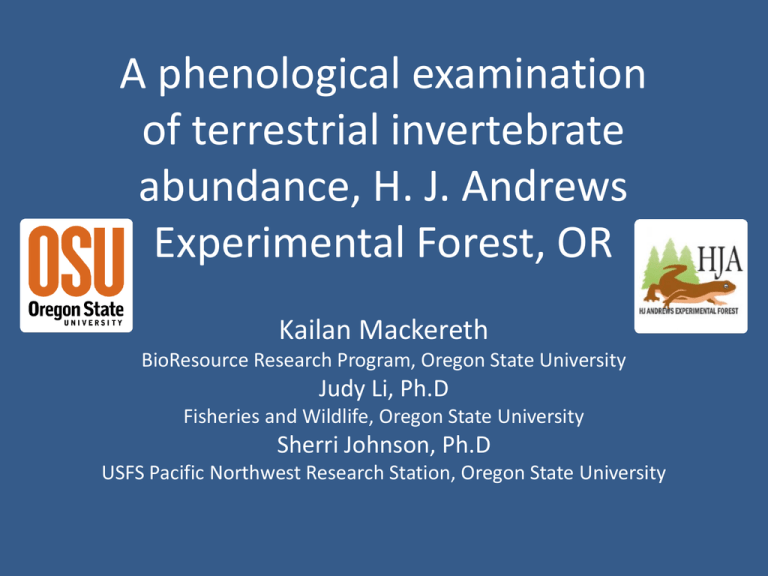
A phenological examination of terrestrial invertebrate abundance, H. J. Andrews Experimental Forest, OR Kailan Mackereth BioResource Research Program, Oregon State University Judy Li, Ph.D Fisheries and Wildlife, Oregon State University Sherri Johnson, Ph.D USFS Pacific Northwest Research Station, Oregon State University What is phenology? Study of cyclic and seasonal natural phenomena http://en.wikipedia.org/wiki/Season Climate Change NOAA Alan Vernon James Gathany AP Photo/U.S. Coast Guard, Petty Officer 2nd Class Kyle Niemi Why Study Insects? Physiology and behaviors regulated by environment Climate changes can alter insect: • Locomotion • Feeding • Mating • Oviposition • Pupation • Eclosion Environmental Influences • Photoperiod – Day length – June 21 – December 22 • Temperature – Hot vs. Cold – Period of warming or chilling Danks 1987 Photoperiod and Temperature • Quiescence – response to environmental conditions – Hibernation – Aestivation • Diapause – programmed & determined – Controlled by environmental factors • Induction • Termination Insect Life Cycles • Ametabolous – No metamorphosis • Hemimetabolous – Incomplete metamorphosis • Holometabolous – Complete metamorphosis Variety of niches and habitats Wikipedia.com Biodiversity Trophic Structure Niches & Habitats Biodiversity! Life Cycle Wilson, Edward Osborne, The Diversity Of Life, (W. W. Norton & Company, 1993), p. 134. Outcomes of phenological shifts • Phenological decoupling of interdependent organisms • Local extinction of unadaptive species ©Doug Linton, Natural Resources Canada • Proliferation of adaptive species http://www.fao.org/docrep/011/i0670e/i0670e02.htm http://chuckpope.com/wp-content/uploads/2011/11/bee-1.jpg © webmink Objective Investigate one season of terrestrial invertebrate response to temperature and corresponding elevational gradients at H. J. Andrews Experimental Forest H.J. Andrews Phenology Core Sites PC Sites PC16 PC18 PC17 PC15 PC14 PC11 PC13 PC12 PC10 PC08 PC05 PC04 PC02 PC01 PC07 PC09 PC01 PC02 PC04 PC05 PC07 PC08 PC09 PC10 PC11 PC12 PC13 PC14 PC15 PC16 PC17 PC18 Elevation (m.) 460 488 481 644 903 647 979 994 1116 1082 1178 965 971 1030 1301 1339 Forest Stage Young Old Young Young Old Old Old Old Young Old Old Old Old Young Old Young Max. Elevation: 1,627 m. Min. Elevation: 411 m. Hypothesis Higher invertebrate abundance will coincide with higher temperatures attributed to lower elevations Methods • Field – 16 sites equipped with malaise traps – Samples every 6-9 days from April 5, 2011 to July 12, 2011 – 172 samples were prepared for laboratory analysis • Laboratory – Total Invertebrate Abundance – Temperature data investigation – Data accumulation and organization Total Insect Abundance PC18 PC18 PC16 PC16 PC17 PC17 PC08 PC08 PC09 PC10 PC10 PC11 PC11 PC12 PC12 PC13 PC13 PC14 PC14 PC15 PC15 PC07 PC07 PC05 PC05 PC04 PC04 PC02 PC02 PC01 PC01 Total Insect Abundance p-value < 0.05 Temperature Data PC17 & PC18 PC09, PC16, PC17, PC18 Cluster Analysis 1 Average Daily Temperatures per Site October 20, 2010 through June 12, 2011 Information Remaining (%) 100 75 50 25 PC01 Avg1 PC04 Avg4 PC02 Avg2 PC05 Avg5 PC08 Avg8 Avg7 PC07 PC10 Avg10 PC14 Avg14 PC15 Avg15 PC09 Avg9 PC11 Avg11 PC12 Avg12 PC16 Avg16 PC13 Avg13 PC17 Avg17 PC18 Avg18 High Temperature Mid Temperature Low Temperature 0 Cluster Analysis 2 Average Daily Temperatures per Site July 16, 2010 through October 20, 2011 Information Remaining (%) 100 75 50 25 PC01 Avg1 PC04 Avg4 PC08 Avg8 PC02 Avg2 PC05 Avg5 PC07 Avg7 PC14 Avg14 PC15 Avg15 PC10 Avg10 PC11 Avg11 PC12 Avg12 PC16 Avg16 PC09 Avg9 PC13 Avg13 PC17 Avg17 PC18 Avg18 High Temperature Mid Temperature Low Temperature 0 Temperature Groups Significant differences in Total Insect Abundance between Temperature Groups p-value < 0.05 n = 29 n = 68 n = 65 Cumulative Insect Abundance +6,286 4,073 2,213 Cumulative Degree Days, Forest Growth, and Total Insect Abundance PC08 PC01 Significant differences in Total Insect Abundance between Forest Types p-value < 0.05 n = 94 n = 68 Summary Greatest abundance occurred at mid temperature sites PC16 PC18 PC17 PC15 PC14 PC11 PC13 PC12 PC10 PC08 PC05 PC04 PC02 PC01 PC07 PC09 Conclusions • Invertebrate abundance or activity depends on many variables, such as: – Temperature – Altitude – Food Supply – Hydroperiod – Aspect/Slope – Precipitation/Humidity – Photoperiod Future Research • Determine species diversity in samples – Species richness – Evenness • Compare diversity across sites • Incorporate site specific variables – Slope – Aspect • Incorporate vegetation and forest growth Future Research “Climate is the average weather in a given place, usually over a period of 30 years.” - EPA Incorporate multiple years of data into one study – Currently have insect data from 2009-2011 – Climate and ecological data extending back to late 1940s Questions? Gratitude • • • • • Judy Li, Sherri Johnson, and Bill Gerth Jay Sexton and Mark Schultz U.S. Forest Service – Pacific Northwest Research Station The Stream Ecology Lab of Nash Hall, OSU BioResource Research Program
